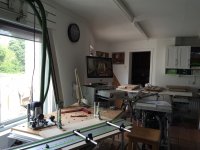JNComplete
Member
- Joined
- Aug 10, 2012
- Messages
- 13
Having purchased the OF 1400 series router last fall, I knew the main purpose was for the day when I could afford the LR32 system. Well after a couple projects under my belt getting used to the system, I am happy to say that it paid off. It's a little daunting at first when you open up the system, try to understand what all the parts do and try to envision yourself flipping the track from one side to the other, and not have it screw up. Is it just me or do most people have this nervousness that you are going to ruin either a part of the tool, like the rail(think 10,000 rpms) or the nice piece of plywood that you so meticulously cut?
I had a pretty good experience with an extra long cabinet side, where I joined up two tracks, while only one had holes. It took some fiddling but it all worked out with indexing, all holes lining up.
That being said, I would like to point out that the instruction booklet that it comes with is greatly lacking, and on the very first page, the one with the illustration, the first picture shows the router as backwards to the guide plate. This makes life very confusing when you're getting familiarized, or re-familiarized. I put my system away for a month and had to re-aquaint myself, and again, it confused me.
In the end, I'm happy I purchased this system. The learning curve is a little steep, but the Youtube videos were so helpful. Thanks to all the great craftsman who put their knowledge out there.
This system though is so precise, its shocking. I do a lot of bookcases and entertainment centers where shelf pins are the norm. The clean holes alone make it worth the cash, but when you couple in dead on accuracy, it's a major improvement to the products I sell.
Thanks Festool!
Jon Nelson
I had a pretty good experience with an extra long cabinet side, where I joined up two tracks, while only one had holes. It took some fiddling but it all worked out with indexing, all holes lining up.
That being said, I would like to point out that the instruction booklet that it comes with is greatly lacking, and on the very first page, the one with the illustration, the first picture shows the router as backwards to the guide plate. This makes life very confusing when you're getting familiarized, or re-familiarized. I put my system away for a month and had to re-aquaint myself, and again, it confused me.
In the end, I'm happy I purchased this system. The learning curve is a little steep, but the Youtube videos were so helpful. Thanks to all the great craftsman who put their knowledge out there.
This system though is so precise, its shocking. I do a lot of bookcases and entertainment centers where shelf pins are the norm. The clean holes alone make it worth the cash, but when you couple in dead on accuracy, it's a major improvement to the products I sell.
Thanks Festool!
Jon Nelson

